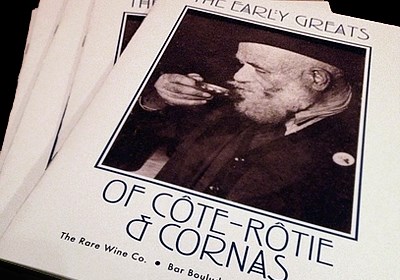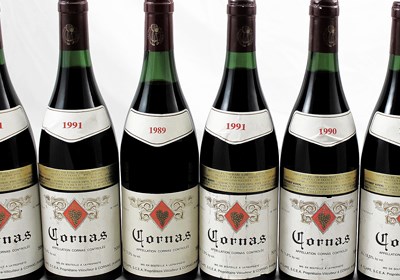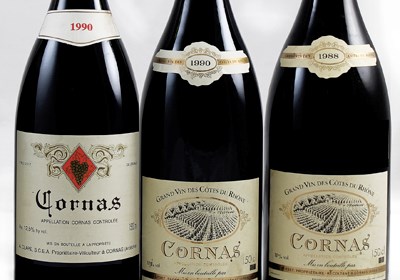
Which site would you like to visit?
By clicking the retail or wholesale site button and/or using rarewineco.com you are choosing to accept our use of cookies to provide you the best possible web experience.
December 12, 2012
Monday night finally arrived, and I could put away the calendar. For more than two months, I’d been counting the days to a tasting that showcased four growers from the past. These were men whose wines have not only become impossibly rare, but represent for me the pinnacle of a school of traditional French winemaking that is today verging on extinction.
The evening paid homage to Noël Verset and Auguste Clape of Cornas, and to Joseph Jamet and Marius Gentaz of Côte Rôtie, four icons of classic winemaking in the Northern Rhône. And there could be no better venue in New York than Bar Boulud, whose wine director Michael Madrigale shares my deep admiration for these great producers. The bottles were my own, having been collected over a period of nearly two decades, and they held more than a few surprises.
The wines were organized in four flights, allowing us to explore both producer and vintage:
Jamet got off to a sizzling start and in my opinion—and I was not alone—it stole the first two flights. Both the ’90 and ’91 Jamet Côte Rôties were amazing: the palates expansive, yet elegant, with great energy and length, and all the elements in perfect balance. And their noses were positively volcanic: explosively deep and wildly complex.
Also standing out in the first two flights were ’90 and ’91 Clape Cornas. (Had the Jamets not been there, they would have been the stars.) When first poured, their bouquets reminded me of the beautiful 1982 Pichon Lalande I’d had just a few days earlier. But both wines quickly moved into classic Northern Rhône territory, with an unleashing of black fruits, tar, leather, and, of course, smoked meat.
I thought the 1990 Clape was particularly impressive, with an elegance that would put to rest anyone’s ill-conceived idea that Cornas is a bruiser of a wine. It was gorgeous.
Verset and Gentaz started out slowly in the first two flights; the wines seemed uncharacteristically subdued. Yet, while these four wines never quite produced the fireworks of Jamet and Clape from the same years, they kept evolving in the glass over three hours. Who knows what their ultimate potential was?
For Noël Verset fans, the highlight of the evening may well have been his 1989 Cornas. Like 1990 Clape, it demonstrated spectacularly the magic that Cornas is capable of achieving. But it also showed the beauty of the best 1989s, with a palate that was ethereal in its delicacy, length and texture. The nose, which exuded roses, followed suit.
Nothing else even came close in the 1989 flight. Gentaz 1989 was beautiful in its balance, but on this particular evening a little unexpressive. Clape’s 1989 lacked the generosity of his ’91 and ’90, while 1989 Jamet was a puzzle. The nose was classic Côte Rôtie, and the palate was big and concentrated, but the wine lacked a bit of elegance. Maybe on another night it would have performed very differently.
Finally came the great 1988s, a vintage that is already legendary for these two appellations. It was the most consistent flight of the night, with Verset, Clape and Gentaz all showing beautifully. The 1988 Verset was cut from the same elegant cloth as the 1989. Clape’s 1988 was fabulous, with great sweetness and black cherry richness and a beautiful spicy nose. As for Marius Gentaz’s 1988, it was only beginning to reveal its potential when we were finishing up for the night. The nose was the deepest of the flight, while the palate was seamless and complete, just begging for more time to reveal the full measure of its greatness.
These men, along with a few other who shared their philosophies, were of a generation that came of age in the 1940s and began to fade away in the 1990s. During their careers, they produced some of history’s greatest Syrahs. Yet, for most of this time, they lived in the shadow of the more famous producers of Hermitage, along with the negociants who for many years bought, blended and bottled their wines.
Even today, Cornas and Côte Rôtie (except for Guigal’s “La-La’s”) seem to lack the name recognition that you’d expect for two appellations that, for the better part of a millennium, were considered among the greatest wine areas of France.
But from the time of Phylloxera in the 1880s until the 1960s, the vines of both became largely abandoned as vineyard workers were lured away by industrial jobs in the cities. By the mid-1950s, the town of Cornas had only 120 inhabitants, compared to 2000 today. The vineyards of Côte Rôtie fell to a little over 100 acres in the ’50s, compared to more than 500 today.
In both Cornas and Côte Rôtie, few growers had the means (or the market) to bottle and sell their own wines. Instead they supplied negociants for their branded blends. It kept the growers both unknown and of modest means. But it allowed a community of negociants to thrive. This included famous names like Paul Jaboulet Aine, Chapoutier, and Vidal-Fleury, the latter conveniently located in Côte Rôtie’s hometown of Ampuis. But it also encompassed countless small bottlers, including Verilhac in the town of Cornas, which bought much of Clape’s production until the 1960s.
I was introduced to the wines of Marius Gentaz, Joseph Jamet, Auguste Clape, and Noël Verset in the mid-1980s, when all four men were in their fourth or fifth decade as a grower. Though the term wasn’t yet applied so liberally, each was a cult producer, with a small, but devoted American following. Whatever modest celebrity they enjoyed here was thanks largely to Kermit Lynch, who represented three of the growers, and Robert Kacher who imported the fourth, Jamet.
When I first started buying their wines, the sought-after vintages were 1978, 1983, and 1985. That didn’t mean that other years weren’t worth buying, drinking, and cellaring; part of the genius of these men was their ability to make wines of character and ageability virtually every year. But the lesser vintages didn’t have quite the same magic, and in those days there were far more modest years than great ones.
But that was soon to change, at least for a time. In 1988, the Northern Rhône entered into a period of glorious weather that would last for four years. Each vintage between ’88 and ’91 was climatically different and produced its own style of wine. But each was great in its own way:
1988: An abnormally hot summer whose wines had profound potential but were so backward that some doubted they would ever round out.
1989 and 1990: Again warm, but not to the same extreme, producing lush, evenly ripe, beautifully balanced wines.
1991: A classic year, not always understood or widely appreciated, that yielded wines of great elegance, refinement and structure for aging.
For Côte Rôtie and Cornas to experience four great vintages in a row was extraordinary. Today, with Europe’s hot summers, we take consistently high-quality harvests for granted . But in 1988, Europe was coming out of three decades of relatively cool weather. It was rare to enjoy four great vintages in a decade, let alone in a row.
The timing could not have been better for Gentaz, Jamet, Clape and Verset. It was a once-in-a-career opportunity as well as the Last Hurrah for Jamet and Gentaz. During this time, Joseph Jamet handed the reins over to his two sons, Jean-Paul and Jean-Luc, after 40 years at the head of his domaine. And in 1994, Gentaz, having no son to take over, turned his vineyards over to his nephew René Rostaing.
Verset and Clape soldiered on. Verset also had no sons, but he somehow managed to produce wine into his 65th vintage in 2006. Clape also kept going, joined by his son Pierre-Marie in 1989. But did either ever again experience a quartet of vintages quite like these?
In Côte Rôtie, these four years also mark the end of an epoch for the style of winemaking practiced by Marius Gentaz and Joseph Jamet. Each had his own approach—including different barrel sizes—but they were both committed to whole-cluster vinification, aging in old wood and the production of a single Côte Rôtie, assembled from all the domaine’s lieux-dits. Blending—as opposed to site-specific bottlings—is often overlooked as a defining characteristic of these growers, but it’s important to understanding their philosophy.
The spirit of Gentaz and Jamet has lived on, but in somewhat updated form. Joseph Jamet’s sons, Jean-Paul and Jean-Luc, would be called by some Côte Rôtie’s most traditional growers, as they, uniquely among the top domaines, blend more than 15 lieux-dits into their flagship Côte Rôtie. But other things have changed chez Jamet, such as the use of about 20-25% new barrels for aging. The sons also practice some destemming, which their father was known never to do.
René Rostaing, meanwhile, has continued the work not only of Marius Gentaz but also his father-in-law Albert Dervieux, another traditional icon. Like the Jamets, he remains largely traditional. He only uses about 17% new barrels and, when the vintage justifies it, will use up to 100% whole clusters. But he long ago adopted the idea of site-specific Côte Rôties, having made his great Côte Blonde and La Landonne cuvées for more than 30 years. In short, he is far closer to a traditionalist than he is a modernist, and his wines show it.
In Côte Rôtie, there are only a handful of other growers who come quite so close to the ideals of Marius Gentaz and Joseph Jamet. In Cornas, on the other hand, there is still the fervently traditional Pierre-Marie Clape, and René Balthazar isn’t far removed in philosophy. And the brilliant Thiérry Allemand has created his own marriage of past and present. But otherwise the approaches of Auguste Clape and Noël Verset—which were largely the same as those of Gentaz and Jamet—are today seen in few Cornas cellars.
But we still have their glorious wines as reminders of a few great men and a unique point in time.
Postscript: In November 2009, we addressed the question of why such great winemaking has gone out of fashion in the Northern Rhône. We specifically compared the situation to Italy’s Piemonte region where a comparable erosion of traditional winemaking has been followed by an inspiring comeback. It’s worth reading.





New discoveries, rare bottles of extraordinary provenance, limited time offers delivered to your inbox weekly. Be the first to know.
Please Wait
Adding to Cart.
...Loading...


By clicking the retail or wholesale site button and/or using rarewineco.com you are choosing to accept our use of cookies to provide you the best possible web experience.

